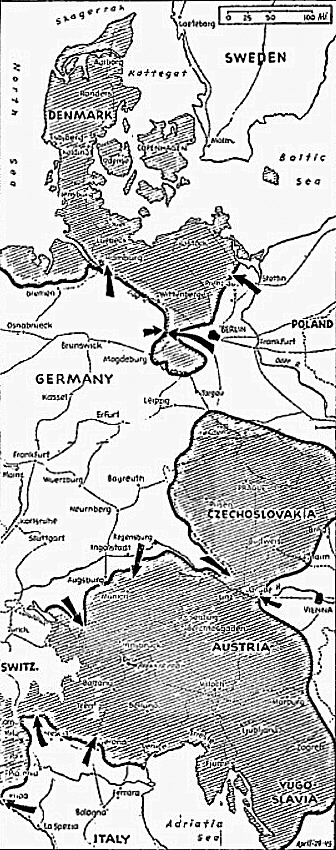The Pittsburgh Press (April 29, 1945)
LAST BERLIN LINE SMASHED
Soviet armies join in center of dying city
Parts of 3 downtown districts captured
Saturday, April 28, 1945
Cutting up the Nazi Army, Allied forces advanced from all directions. In the north, the Second White Russian Army drove far west of Stettin. Soviet troops gained inside Berlin, and drove to the Elbe River to the west. In the south, the U.S. Third Army in Austria near Passau advanced toward a junction with the Russians along the Danube. To the west, the U.S. Seventh Army closed in on Munich, where an anti-Nazi revolt road, and crossed into Austria to the southwest. In Italy, U.S. troops were reported to have reached the Swiss border at Como.
LONDON, England (UP) – The Red Army, breaking through Berlin’s last defense line to the Alexander Platz, captured parts of the three central districts of the doomed capital, today.
The German radio reported Nazi parachutists were dropping into the city in a last, desperate reinforcement gamble.
The First White Russian and First Ukrainian Armies joined forces at the western edge of the Berlin downtown area, a Moscow communiqué announced.
More than 45,000 Germans had been killed in two days in the hopeless defense of the city and 14,000 prisoners were taken from a huge trap southeast of the city where survivors are being “annihilated.”
Beyond falling capital
Forces of three Soviet armies were storming on beyond the falling capital and had gained up to 25 miles in an overwhelming offensive that was ripping what remains of Germany to shreds.
Marshal Gregory K. Zhukov’s First White Russian Army captured the big electrical works settlement of Siemensstadt, the Moscow communiqué said – revealing that the town had been temporarily lost following its first reported capture three days ago.
The Russians then stormed through the northwestern quarter of Charlottenburg and reached the Bismarckstrasse, a continuation of the Charlottenburger Chaussee and Unter den Linden – the main axis of the German defense. They also seized the western half of Moabit, just east of Charlottenburg and site of Moabit Prison.
Marshal Zhukov’s tank forces in Eastern Berlin moved west from the fallen Tempelhof district to seize half of adjoining Schoenberg.
Swinging up through Berlin’s southwest section, Marshal Ivan S. Konev’s First Ukrainians captured the town districts of Friedenau, Grunewald and Ruhleben and linked up with the First White Russians.
A German High Command communiqué admitted that Zhukov’s tank teams had broken through to the Alexander Platz, eastern anchor of the Unter den Linden line. They also penetrated to Berlin’s Waterloo Circle to the southwest, only 1,000 yards from the Reich Chancellery, the communiqué said.
Turn backs on Yanks
German defenders of the erstwhile Western Front were reported “turning their backs” on the Americans in an effort to fight through to the relief of Berlin.
The Germans still held 30 square miles of Berlin, based on the Tiergarten, Unter den Linden and the Friedrichs, Potsdam and Anhalter stations. Heavy Soviet cannon, in one of the most terrible barrages of history, were obliterating everything inside that pocket.
The Germans insisted Adolf Hitler was staying in Berlin to meet a Wagnerian death. Moscow broadcasts said he had fled to the Austrian Tyrol and had made a brief flight from there to the Baltic port of Flensburg, described as the emergency seat of the German High Command.
Marshal Konstantin K. Rokossovsky’s Second White Russian Army struck swiftly to forestall a protracted German stand in Schleswig-Holstein, where Flensburg lies, and Denmark. Marshal Joseph Stalin announced his troops had captured the Pomeranian strongholds of Eggesin, Torgelow, Pasewalk, Strasburg and Templin.
Templin is 30 miles north of Berlin, 48 miles southwest of Stettin and 100 miles from British Second Army troops at the Elbe. Reaching Templin in an overnight advance of 25 miles, Marshal Rokossovsky’s forces were driving beyond fallen Stettin and north of Berlin on a 45-mile front with a speed that promised to overrun Germany’s “northern redoubt” in a matter of days.
Linking on 85-mile front
Moscow indicated the Allied armies were linking up on an 85-mile front from Torgau north to the Elbe west of Rathenow, where Cossack horsemen had driven 14 miles to the river from the captured town. The U.S. Ninth Army was on the Elbe west bank there. After the initial linkup at Torgau, Moscow dispatches said, two other Soviet divisions made contact with corresponding U.S. forces farther downstream.
German “mobile reserves,” presumably parachutists, as well as food and ammunition were landed in the city, the Nazi communiqué said in an indication of the desperateness of the situation.
